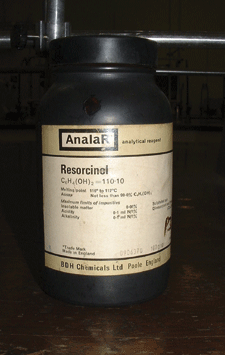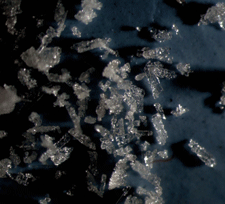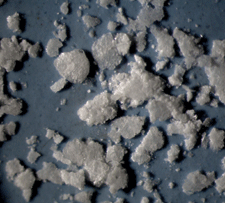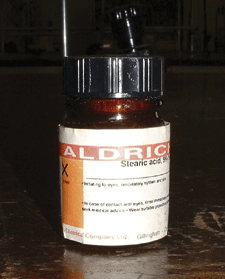Dr Glynn Walsh concludes his review of the raw materials used by manufacturers of frame materials
In the issue of June 17, optician covered the dermatological effects of additives and extras from Abietic acid through to Ethylene acetate. Here we complete the A-Z with Ethylene glycol through to Turpentine. Ethylene glycol has been reported as a cause of contact dermatitis when used as a solvent to join nose pads to plastic frames.1,2 However, it does not appear to be a satisfactory solvent for any spectacle frame material currently in use. It is much better known as an 'anti-freeze' used in motor vehicles.
Ethylene glycol has been reported as a cause of contact dermatitis when used as a solvent to join nose pads to plastic frames.1,2 However, it does not appear to be a satisfactory solvent for any spectacle frame material currently in use. It is much better known as an 'anti-freeze' used in motor vehicles.
Ferric oxide is better known as rust, but fine ferric oxide powder is commonly used as an abrasive for polishing in which context it is often called 'rouge'.
Formalin has been reported as causing dermatitis from some 'synthetic horns',3 but there is no recent evidence for this and the inclusion of both spectacle frames and telephone receivers would imply that the now wholly obsolete casein-formaldehyde or similar was the likely source when there were supply restrictions during the Second World War.
Glyceryl triacetate is a plasticiser, reported by Smith & Calnan3 as being largely discarded by 1966. There have been no further reports since their review.
Make-up can cause skin reactions where it is on the surface of a spectacle frame which is in contact with the face, and is a factor which should sometimes be eliminated before coming to the conclusion that a change of spectacles will resolve any dermatological problems.4
Methyl methacrylate is the monomer used in the production of poly-methyl methacrylate. It has been reported as probably being present in clinical quality PMMA contact lens blanks,5 but not in spectacle frames. However, where PMMA is used, such as for coating metal frames, trace amounts would be expected to remain. There are no reports of any skin problems from it in the context of spectacle frames, but there is an extensive literature relating to skin reactions to monomers in dental technicians and patients and others.6
Nail varnish is not part of a new spectacle frame, but is commonly used in an attempt to reduce or eliminate skin reactions due to spectacle frames, particularly those containing nickel. It has been suggested as a potential allergen in itself when used this way.7
Organo phosphates is a grouping including tricresyl phosphate, tri-phenyl phosphates and phosphate esters, all of which have been reported as being present in spectacle frames. In general terms, organo-phosphates have been a 'hot topic' for a number of years, but entry into this debate is outside the scope of this review.
Para-phenylenediamine is used in the production of azo and anthraquinone dyes has been reported to cause contact dermatitis in spectacle frames.3,8,9 The substance has been in the news a lot lately because of adverse reactions to it from hair dyes. The use of dyestuffs likely to have para-phenylenediamine as a breakdown product in use is now controlled, but this does not yet appear to affect spectacles.10

Resorcinol bottle and crystals
Para-tertiary butylphenol formaldehyde resins have been suggested as possible sensitisers in spectacle frames,11 but the author has been unable to determine their role in the spectacle industry. They have also been reported as allergens in watch straps12 and a hearing aid.13 Population incidence of skin reactions to this substance is typically about 1.5 per cent of an allergic population.14
Phenyl salicylate is sometimes used as a UV inhibitor in these cellulose plastics materials and has been reported as causing dermatitis in spectacle frames.15 It has also been shown to leach from dental materials in vivo16 and to cause an allergic response in skin creams.17 It has also been reported to cross-react with resorcinol and resorcinol monobenzoate.18
Phosphate esters other than triphenyl phosphates have been implicated in spectacle allergy,19 although these authors did not know which phosphate esters were present.
Polishes - there is very little information available on polishes used on spectacle frames, although the use of colophony appears to have declined considerably in recent years. Jordan20 found a patient sensitive to turpentine/beeswax polish. Another common polishing material, used normally for buffing frames in practice, is iron oxide ('rouge').
Resorcinol and resocinol monobenzoate are UV inhibitors, once common in cellulose acetate plastics. Both have been reported as being present in and causing dermatological problems with spectacle frames.2,11,15,18,21-22 Fisher11 also states that resorcinol is no longer used in spectacle frames. However, it is not clear if this applies to frames which are not available in the US. Interestingly, Ongenae et al23 claimed that it was still the most important allergen in plastic spectacle frames. The general literature on resorcinol allergy is too extensive to enter into here, although there appear to be no reports of the incidence of allergy to these substances other than among hairdressers in which group the incidence is about 1 per cent.24
Rosin is effectively an alternative name for colophony, described on June 17. It is used in polishes and many non-optical products, although its best-known use is probably by violinists on their bows.
Rouge is another name for ferric oxide, used as a polish. It is often mixed with waxes.
Stearic acid was reported as being present as a lubricant in sheet cellulose acetate by Smith & Calnan,3 but the UK manufacturer from whom they must have obtained their information ceased production soon after their publication. Despite the number of synonyms for the substance, it seems not to have been reported in this context since then.


Thiurams are accelerators used in the curing of rubbers. Although these would not normally be expected to be present in spectacles in the UK they have been reported as a cause of dermatitis from 'rubberised spectacle retainers' used to stabilise spectacles during vigorous physical activity.25
Toluene sulphonamide was reported as a plasticiser, apparently not used in the UK, but probably still in use elsewhere, by Smith & Calnan.3 There is no evidence of its continued use in spectacles, although it is still used in plastics production.
Tricresyl phosphate is a plasticiser, although Smith and Calnan3 were doubtful as the validity of the tests carried out in the case of spectacles dermatitis which they cited. Its presence has also been suggested by Andersen19 and Carlsen et al.26
Tri-phenyl phosphates are a large group of compounds and it is not clear which have been used in spectacle frames other than C6H5O3PO.3 These materials have been used as plasticisers in cellulose acetate frames26 and also reported to cause contact dermatitis on a number of occasions, sometimes at very low concentrations.27,28
Turpentine is used in polishes and the production of colophony. Jordan2 suspected a case of allergy to Optyl, but testing revealed that the sensitiser was a turpentine/beeswax polish.
Register now to continue reading
Thank you for visiting Optician Online. Register now to access up to 10 news and opinion articles a month.
Register
Already have an account? Sign in here
